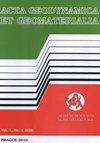势场数据综合应用在利比亚吉法拉平原构造要素及基底深度圈定
IF 0.8
4区 地球科学
Q4 GEOCHEMISTRY & GEOPHYSICS
引用次数: 0
摘要
本研究利用利比亚石油研究所的地面重力数据和非洲磁测项目的航磁数据进行分析,圈定了利比亚西北部吉法拉平原的构造要素和基底深度。对重力和航磁数据分别采用高通滤波和极降变换。将总水平梯度和勘探目标中心(CET)网格分析应用于重力数据集。对RTP磁资料进行了Werner反褶积处理。将一个二维正演剖面应用于重磁数据集。结果表明,重力异常高和磁异常具有不同的构造走向。Werner反褶积剖面显示,在沉积层序内存在高密度侵入体(距地表约1.8 km)。该侵入可能是Gharyan地区附近始新世火山活动的结果。二维模型显示吉发平原基底深度在2.8 ~ 3.0 km之间。重磁数据集的综合结果反映了吉法拉平原及其邻区不同时期的构造活动。本文章由计算机程序翻译,如有差异,请以英文原文为准。
Delineation of structure elements and the basement depth at the Jifara plain NW LIBYA using integration application of potential field dataset
In this study, the analysis of ground gravity data (from the Libyan Petroleum Institute) and aeromagnetic data (from the African Magnetic Mapping Project) are used to delineate the structure elements and basement depth within the Jifara plain, northwest Libya. A high-pass filter and a reduction-to-the-pole (RTP) transformation are applied to the gravity and aeromagnetic data respectively. The Total horizontal gradient and Centre for Exploration Targeting (CET) grid analysis are applied to gravity datasets. Werner deconvolution is applied to the RTP magnetic data. One 2-D forward modelling profile is applied to gravity and magnetic dataset. The results show gravity anomaly highs and magnetic anomaly with different structure trends. Werner deconvolution profile shows a high-density intrusion (about 1.8 km from the surface) within the sedimentary sequence. The intrusion may be the result of the Eocene volcanic activities near the Gharyan region. The 2-D model shows that the basement depth of Jifara plain ranges from 2.8 to 3.0 km. The integration results of the gravity and magnetic dataset reflect various periods of tectonic activities within Jifara plain and the adjacent area.
求助全文
通过发布文献求助,成功后即可免费获取论文全文。
去求助
来源期刊

Acta Geodynamica et Geomaterialia
地学-地球化学与地球物理
CiteScore
2.30
自引率
0.00%
发文量
12
期刊介绍:
Acta geodynamica et geomaterialia (AGG) has been published by the Institute of Rock Structures and Mechanics, Czech Academy of Sciences since 2004, formerly known as Acta Montana published from the beginning of sixties till 2003. Approximately 40 articles per year in four issues are published, covering observations related to central Europe and new theoretical developments and interpretations in these disciplines. It is possible to publish occasionally research articles from other regions of the world, only if they present substantial advance in methodological or theoretical development with worldwide impact. The Board of Editors is international in representation.
 求助内容:
求助内容: 应助结果提醒方式:
应助结果提醒方式:


